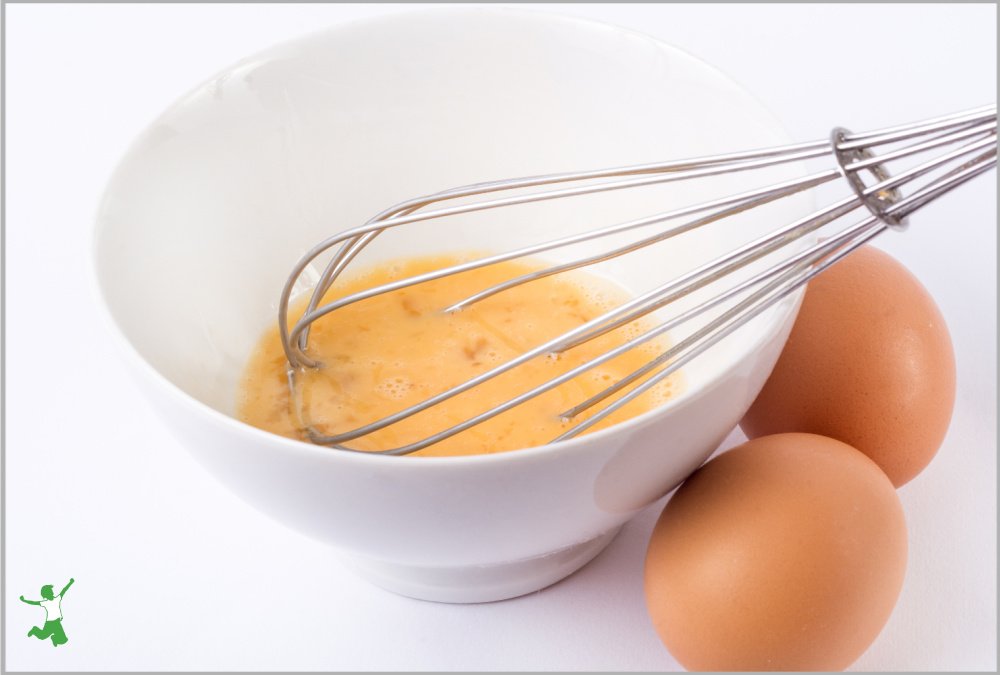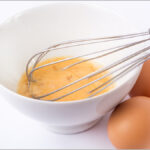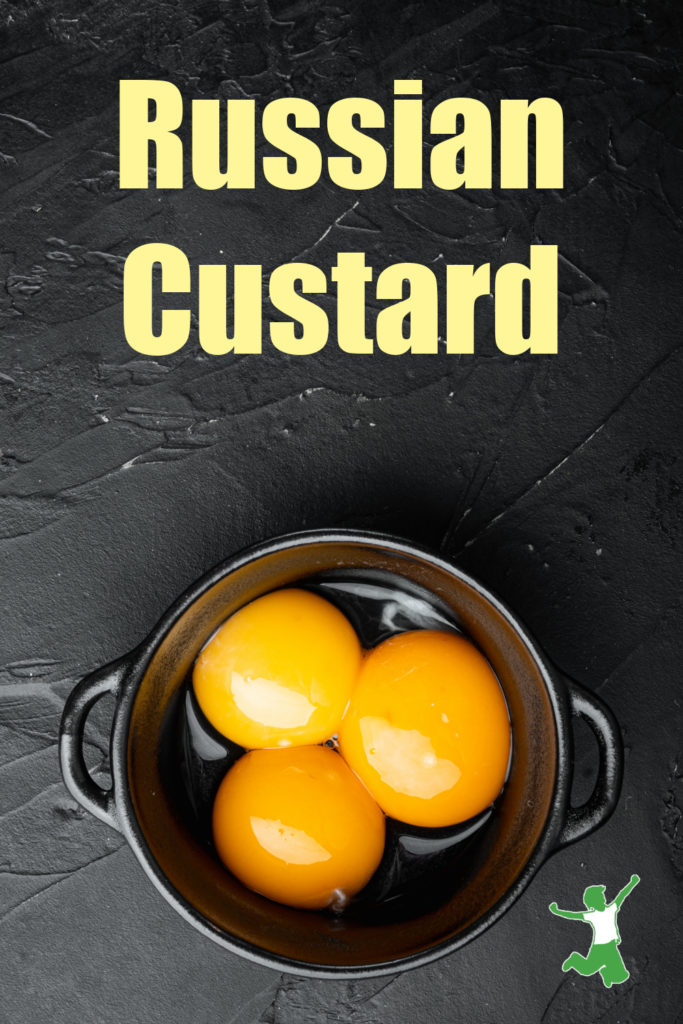How to make nutritious Russian Custard, an easy-to-make, nourishing substitute for dairy cream for all your savory and sweet recipes.

Russian custard is an excellent alternative to dairy cream. It can be enjoyed on its own with nuts or fruit or as a substitute in any recipe that calls for cream.
Coconut cream and cashew cream are other good alternatives to dairy cream for those who do not tolerate eggs.
Why would you consider using egg yolks instead of dairy cream?
If you recall, fresh cream even if raw is not permitted on the GAPS autoimmunity protocol as it contains lactose (milk sugar).
This natural sweetener is a disaccharide (double sugar). This molecule is not easily digested in a compromised gut environment. By comparison, honey and fruit are permitted as they are monosaccharide sugars.
Once the gut heals, lactose can be metabolized quite easily. Thus, avoidance of dairy cream is only a temporary measure on the GAPS diet.
Yolk Quality is Key
The key to Russian Custard is the quality of the eggs you use.
Deep yellow and orange yolks are one of the highest food sources of choline. This critical nutrient protects the liver from overconsumption of sugar, refined carbohydrates, and processed seed oils.
The best egg yolks are from your own backyard chickens. Second best is unwashed eggs from a neighbor or farmer’s market.
Coming in a distant third would be eggs from the store. Washed eggs even if organic are best avoided if you can get fresh, unwashed versions in your community.
Good quality egg yolks in the diet are a very wise investment of your food budget dollars.
Serving Suggestions
In addition to fruit, Russian Custard is delicious topped with a handful of chopped nuts.
The raw nuts should be soaked in brine overnight and then dehydrated before eating. This method vastly improves digestibility.
You can also use sprouted nuts if you are short on time. This is the brand I use.
What to Do with Leftover Egg Whites
There are a number of creative ways to use up the egg whites leftover from making Russian custard.
Tip: Separated egg whites will stay fresh for several days in a glass container with a lid in the refrigerator, so don’t feel pressured to use them immediately.
Two of my favorite methods to use a lot of egg whites at once are these delicious protein cookies or grain-free angel food cake!
**This recipe is adapted from Gut and Psychology Syndrome by Dr. Natasha Campbell-McBride MD, who herself is of Russian heritage.

Russian Custard Recipe
How to make nutritious Russian Custard, an easy-to-make, traditional substitute for dairy cream for all your savory and sweet recipes.
Ingredients
- 8 egg yolks preferably pastured
- 4 tsp raw honey preferably local
- sprouted nuts optional, chopped
- fresh fruit optional, chopped
Instructions
-
Wash eggs gently in warm, soapy water and then dry.
-
Separate egg whites from yolks and set whites aside. In a medium-sized bowl, add the honey to the egg yolks and whip with a whisk until the mixture thickens and the color lightens to a pale yellow.
-
Serve immediately with fruit or nuts or add to recipe of choice in place of cream.
-
Refrigerate leftovers, which will last several days in a glass bowl with a tight-fitting lid.
Recipe Notes
If keto or ultra low carb, reduce or substitute the honey with a few drops of stevia extract or a pinch of monkfruit.

More Healthy Pudding Recipes
Egg Custard Pudding
Vanilla Pudding Recipe
Bread and Butter Pudding
Jello Pudding
Macadamia Nut Pudding
Coconut Milk Pudding
Thai Custard
Homemade Chocolate Pudding








Russian custard is known as Zabaglione in Italy or Sabayon in France. Sugar is
traditionally used: 1 – 2 Tbsps as well as Marsala wine or Grand Marnier (personal
preference) I used to make this for my children when they were growing up in a
large copper bowl over hot water. Whipping the egg yolks creates the volume.
A sweetener is just that: to sweeten. It is delicious and healthy.
Bon appetito!
I was reading some of the comments, and noticed you mentioned date sugar. I don’t know much about date sugar except for the fact that it comes from dates. Wouldn’t it be considered “processed” ?? In other words, how do they get the sugar out of the dates?
My sister loves Russian custard! The only problem is she hates taking the time to whisk it with a fork.
In the picture you have it looks like you’re using a electric whisk…. Are you? And what brand is it? It would be so much easier to make the Russian custard if we didn’t have to stand there and beat our arms off!
Oh this is eggcellent!!! I’m always looking for new things to do with eggs since my chickens make more than I can eat. Plus I have to cut corners with my raw dairy budget and cream is wildly expensive. So I can use this for all those wonderful cream based recipes I keep getting through Real Food Media 🙂
Also, LOVE the bonus you gave use with some egg white ideas. I use/eat a lot of yolks but I hate wasting the whites. I’m going to make these protein cookies soon!!!
Excellent! For months my family has been enjoying the protein cookies linked in your post – which require 8 egg whites. But now I have 10 little containers of frozen yolks in my freezer (frozen in 3’s for making ice cream). From now on, I’ll just make Russian Custard and save the space in my freezer. Perfect!
Sounds delicious! You can also use part of a rinsed shell in your water kefir to add minerals.
There’s info in the new edition of Gut & Psychology Syndrome which I think may be different from the original one with regard to introducing dairy. I’m not sure how different it is — maybe somebody could confirm this. I know it talks about using homemade sour cream pretty early on in the process (just checked, First Stage of Intro, actually), as a high fat, as opposed to high protein, dairy food. On p. 148 she talks about introducing sour cream made with yoghurt culture first, and then sour cream made with kefir culture. This would be after using the overnight sensitivity test on the wrist to be sure it’s tolerated. In any case, maybe using homemade sour cream would be a fun variation to try for your recipe.
Wow, I never thought of this as a ‘recipe’ or anything Russian… this was what my father served me when I was sick, especially for a sore throat, when I was a child. It was my favourite treat! Perhaps he learned it from his Russian father or Polish mother. I’ll have to start making this for a treat more often.
How do we enter the contests to win products ? Are they on your site here and I am just missing them?
Also, are the soaking times in Nourishing Traditions adequate for grains, legumes and rice? There is some discrepancy between this book and the How to CurelTooth Decay, I think.
Thank you
Marie
I soak my grains and legumes for 24 hours. I know that NT says overnight is sufficient but also suggests a 24 hours soak, so soak for the longer period of time and it does seem to improve digestibility.
I have giveaways periodically that are announced in blog posts. I do not have one going on presently. The best way to never miss one is to subscribe and then you don’t ever miss a post.
Is honey there for just the sweetness or for consistency as well? My wife is allergic to honey so would this work with stevia?
R
I don’t know if stevia would be a good substitute or not.
After thinking about it more, I’m thinking stevia would not work as the raw honey and the egg yolk whipped together seem to change the consistency of the custard as it thickens and the color changes kind of like what happens when you whip cream into butter. Using stevia would not produce the same effect I do not believe.
Why couldn’t she use a little maple syrup? Different flavor but might work.
Maple syrup might work but maple syrup is a disaccarride (double sugar) so if one is making Russian Custard as a sub for cream, then maple syrup would not be an option. Only honey, date sugar are single sugar molecule sweeteners from what I’ve read. I don’t think date sugar would work as it is granular. But, if someone is not on GAPS and wants to use maple syrup, that might work as an option though I don’t know if the custard would thicken up like it does when the egg yolks are whipped with raw honey.
Would a simple syrup made with date sugar work? I don’t have the money to run out and try this, I’m asking for a “what if.”
Try Agave nectar.
But did you know that the process in which they create agave syrup is the exact same one by which high fructose corn syrup is produced?
That’s right. All that chemically-intensive, factory-made fakeness applies to manufactured agave “nectar” just as much as HFCS. Using all sorts of toxic chemicals, caustic acids, and genetically-modified enzymes, they take the starch of the root bulb from the agave plant, and, just like with the starch from corn, put it through the processing ringer transforming it almost the exact same way into not much more than free synthetic fructose and a bunch of chemicals.